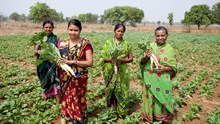
Common name: Ber
Botanical name: Ziziphus mauritiana
Family: Buckthorns
Origin: India and China
Introduction:
-
Ber is the crop suitable for arid conditions.
-
It is quite common fruit in India also known as poor man’s fruit.
-
It is easy to cultivate and requires less maintenance. This is the reason that its commercial cultivation is in demand.
-
Ber is rich in vitamin A, B and C. It is helpful in improving immune system and treating insomnia and anxiety.
-
The main states cultivating ber crop are Haryana, Maharashtra, Gujarat, Punjab, Rajasthan, Madhya Pradesh, Bihar, Andhra Pradesh, Telangana and Tamil Nadu.
Climate:
-
Being a hard plant, ber can grow successfully even in unfavorable climate but arid and semi-arid conditions are the best for its cultivation.
-
Cultivation of ber requires hot and dry climate and sufficient amount of moisture at the time of fruiting.
-
At the time of development it requires dryness in atmosphere.
-
Excessive humidity in atmosphere would affect the productivity of the crop.

Soil:
-
Ber is resistant to drought and water logging.
-
Cultivation of ber is possible in wide range of soil ( saline, alkaline, clayey and sandy soils)
-
It performs comparatively well in sandy loam soil.
Season:
-
Sowing time of ber is generally done at the beginning of monsoon.
-
We can also sow the seeds of ber in the months of January-March in the irrigated areas.
Fertilizer and Manure:
Amount of fertilizer and manure differ on the bases of preferred method of cultivation and climatic conditions.
List of fertilizer and manure is given below:
|
Fertilizer and Manure |
Rainfed areas
|
Irrigated areas |
|
FYM |
30 kg/tree |
60 kg/tree |
|
Nitrogen |
100 g/tree |
500 g/tree |
|
Phosphorus |
50 g/tree |
400 g/tree |
|
Potassium oxide |
50 g/tree |
400 g/tree |

Land preparation:
-
A proper ploughing, harrowing and leveling should be done before the cultivation of ber.
-
Land should be free from weed.
Variety:
Varieties of ber with their yield are mentioned below:
|
Variety |
Yield (kg/tree) |
Features |
|
ZG 2 |
150 |
Spreading type of tree, medium sized fruits, resistant to powdery mildew disease |
|
Sanaur 2 |
150 |
Large sized fruits, sweet in taste, resistant to powdery mildew. |
|
Umran |
150-200 |
Oval shaped fruit, glossy, chocolate brown fruit. |
|
Wallaiti |
114 |
Golden yellow in color, soft pulp. |
Plant spacing:
Plant spacing: 7×7 metre in pits of 60cm×60cm×60.
Irrigation:
-
It is essential to irrigate when plant is in stage of dormancy.
-
Established tree does not require frequent irrigation.
-
Fruit developing is another crucial stage when proper irrigation is needed.
-
We can stop the irrigation in second fortnight of March.
Harvesting:
-
It is important to harvest the fruit at the right time of maturity.
-
We can proceed our first harvest within 2 to 3 years after the period of plantation.
-
Harvesting late can cause fruit ripening and can affect the taste of fruit.
Storage:
To increase the life of fruit, pre-cooling of fruit at the temperature of 100c is required.









